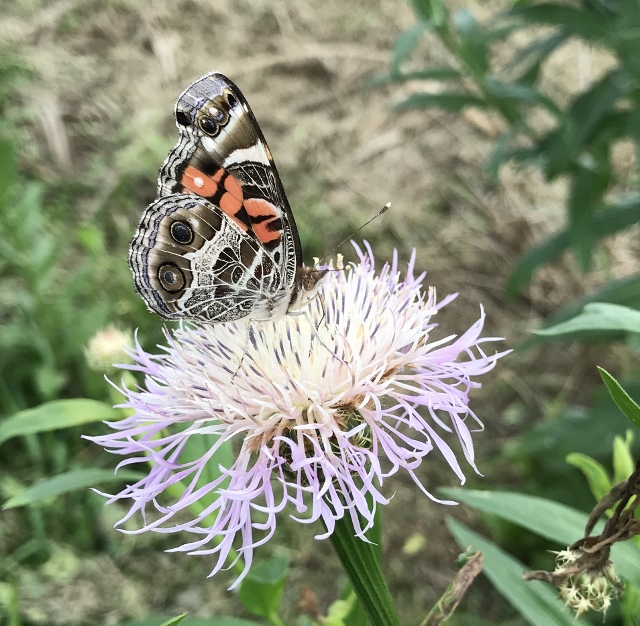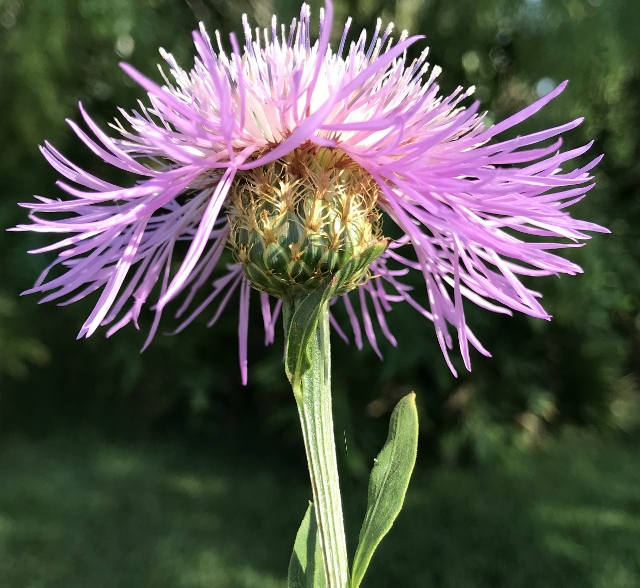Story and photos by Anita Westervelt, Texas Master Naturalist

The first task when identifying a plant is to find its botanical name. Once you have that, it’s easy to use a search engine and find information.
Finding a botanical name is easy when using a mobile device. Many apps can help identify plants, birds, bugs reptiles and other things found in nature.
One easy-to-use phone app, and online source, is iNaturalist (www.iNaturalist.org), a joint initiative by the California Academy of Sciences and the National Geographic Society. It is a crowdsourced species identification system, according to its website, available to anyone with a computer or smartphone access with Internet.
The photographs accompanying this story were uploaded to www.iNaturalist.org which supplied the botanical names: the native basket flower, Plectocephalus americanus, and the non-native species, basket plant, Callisia fragrans.
Basket flower is an important butterfly nectar plant. It re-seeds itself and begins pushing up new plants in March giving a showy display of flowers April through May. A collection of bracts at the flower’s receptacle make it look like a woven basket, hence the name, basket flower.

The blooms attract pollinators and interesting bugs. Tiny, pollen-laden furrow bees greedily wallow through the flower head. Dark flower scarab beetles scrabble into the depth of the flower. Butterflies lightly land on the petal tips and draw nectar from the flower’s center. Not-so-useful leaffooted bugs pierce various plant parts and suck the juice from the plant. Photos uploaded onto iNaturalist identified species visiting the flowers.

Basket plant, on the other hand, is native to Mexico and parts of South America. Some note that it has become naturalized in much of the southern United States. Others caution that it may become invasive in the Valley’s hot, humid climate.

Basket plant gets its name because the base of its flower looks like a basket. The rosette of sturdy green leaves is what most people find attractive. The plant shoots out runners that grow into large rosettes. Runners on the ground will root. Some like this plant for a ground cover in partially shaded areas. Equally attractive is using it in a hanging basket — which waylays its attempts to become invasive. It’s also a fun patio container plant. It survived, and thrived, through winter neglect with only bright light and occasional watering.
An opportunity for Valley residents to use the iNaturalist app or online link is coming up. Annually, this time of year, the citizen science staff at the Natural History Museum of Los Angeles County (California) and California Academy of Sciences organize a City Nature Challenge — worldwide. This bioblitz-style competition uses iNaturalist and was started to encourage people to find and document plants and wildlife in a friendly competition.
In light of the COVID-19 pandemic, the organizers have changed the focus from a competition to a collaborative aspect that will embrace the healing power of nature.
Citizens, throughout the globe, are encouraged to join this year’s efforts in a shelter-at-home-backyard-observation event. The documentation is no less important than in previous years. The dates of the City Nature Challenge are Friday, April 24 through Monday, April 27.
For more information and to learn how to use iNaturalist, and to join the activity, visit https://citynaturechallenge.org/
